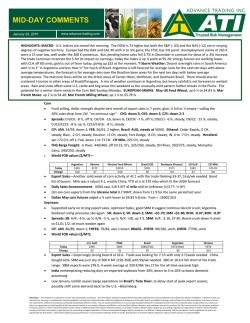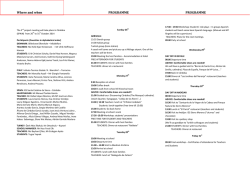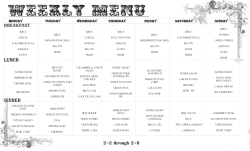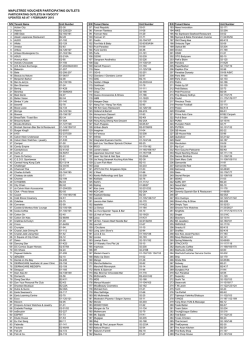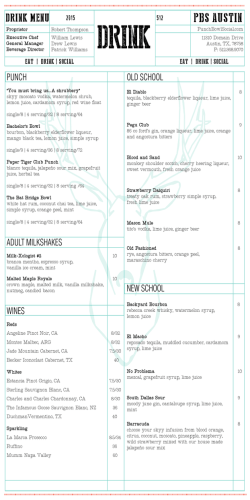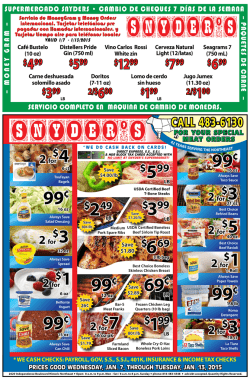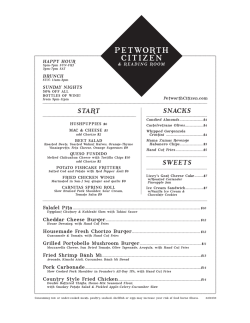
Market Report - Cheney Brothers
MARKET NEWS Weekly Market Newsletter February 9, 2015 THIS WEEK ______________________________________ ■ Market Update and Transportation Facts ■ 7 Common Restaurant Marketing Myths Busted ■ Grocers, Get Ready For Generation Z ■ Mobile Moves in on Grocery Shopping ■ National Weather Spotlight ■ Commodities at a Glance ■ Equipment and Supplies Update ■ CBI Non-Food Item of the Week ■ What’s NEW at Cheney ■ Weekly Poultry Commentary ■ CBI Dairy Update ■ Center of the Plate We insist upon top quality products from nationally recognized manufacturers. Our broad inventory of more than 15,000 supplies features the finest items, from gourmet to everyday. Never content to rest on our laurels, we strive to continuously improve and innovate our products and services. This commitment to excellence has served our customers well for more than 80 years, and continues to serve as our standard for success. ■ What’s New from Coast to Coast ■ Weekly Flour Market Highlights ■ Perfect for the Big Game -Byron Russell Chairman & CEO ______________________________________ Riviera Location One Cheney Way Riviera Beach, Fl. 33404-7000 800.939.4018 Ocala Location 2801 W. Silver Springs Blvd Ocala, Fl. 34475-5655 Leading Food Distributor Serving the Southeast and the World Since 1925 800.432.1341 TRANSPORTATION FACTS: *The National Deiseal Average (reported on Mondays) has fallen to $2.83 per gallon, which is a $.04 drop from last week’s price. *The average price for a gallon of diesel fuel is $1.12 lower than the same time last year. *Fuel prices fell in all areas of the country except New England, where a $.01 per gallon increase was seen. *The cheapest fuel can be found on the West Coast (less California) where a gallon of diesel costs $2.72. The most expensive fuel can be found in the Central Atlantic at $3.04 per gallon. *The WTI Crude Oil Price is on the rise this week, moving from $46.39 to $53.05 a barrel which is a 14% increase. *With flat demand, transportation supply is adequate in most parts of the country this week. Potato and onion shippers are seeing better availability and have been upgraded to “slight shortage” status. On-Highway Diesel Fuel Prices Market Update Tomatoes: Although Florida’s Winter tomato volume continues the seasonal decline, quality remains very good on all varieties. Rounds and romas are meeting market needs while grape tomato availability is a bit limited. Yields will likely continue to decline gradually until the Spring season gets cranked up in March. Tomato production numbers are slightly lower in Western Mexico this week but there is plenty of fruit available. Quality has been consistently good on all varieties except cherries, which are crossing with reports of scarring and inconsistent ripening. Bell Peppers: Both Eastern and Western growers continue to have steady supply and good quality on green bells this week. Cucumbers: The East continues to enjoy a steady supply of cucumbers from Honduras. Mainland Mexico farms weren’t able to harvest over the weekend due to rain, but are back on track with solid volumes this week. Green Beans: With Guasave back in action and Culiacan still in good supply, Western markets are seeing nice quality and availability on green beans. In the East, Florida’s bean production is lighter this week, in part due to weather conditions. Eggplant: Florida farms are now in lighter plantings of eggs but are still able to meet market demand with nice-quality fruit. Mainland Mexico has good supply of all sizes of eggplant as well. Summer Squash: Warmer weather has Florida’s squash production back on track this week. Quality is good now, but we expect to see some wind damage and scarring from previous weather in the next few weeks. The two major growing areas in Mexico are both crossing product. Mainland Mexico has seen moderate increase in production this week, while southern farms have lighter supply due to cool weather and field transitions. Quality is just average on yellow, but good on zucchini. Hard Squash: Although Florida has very light volume, the majority of the nations’ hard squash is leaning toward larger fruit and there are reports of moderate scarring, minimal ground lay, and a range of color. New hard squash plantings are set to begin in mid–February in Sonora with more coming in March and April. Chili Peppers: Tomatillos are the only chili with limited availability from Mexico. Other varieties have good volume coming from Sinaloa and Baja although quality can be varied. Some lots are showing this walls, weak stems and mixed sizing. Florida maintains a steady, but light volume on select chilies for the East. Figuring out the right marketing mix for your restaurant is not an easy task, especially amidst all of the other responsibilities and challenges of running a successful restaurant business. When it comes to marketing your restaurant, the options can be endless and overwhelming. And while it may take some time to discover the right marketing mix for your restaurant, a good first place to start is to be aware of these biggest marketing myths to avoid and why. 1) Having a mobilefriendly website is a nice-to-have feature, but not mandatory. If somebody tells you that your restaurant’s website looks ok or is good enough, if it’s not mobile friendly then you are missing out on important opportunities to attract new customers. For instance, research conducted by Chadwick Martin Bailey with SinglePlatform from Constant Contact reveals that 81 percent of consumers surveyed searched for a restaurant using a mobile app in the last six months. If you don’t give users an enjoyable browsing experience on their mobile phones you will lose them. 2) Discounts are the key to winning customers. Sure, everyone loves a good deal, but if you are overly discounting your products you could be hurting your business. Yes, draw in customers with discounts but only if they make sense for your business. But also beware of devaluing your restaurant with too many coupons and promotions. 3) Having great food will make my restaurant successful. Great food is, of course, an important must-have for any successful restaurant but it’s not everything. With intense competition facing today’s restaurants, you need to always be finding new ways to attract new customers and keep existing ones happy. 4) Marketing is just too expensive and not in the budget. There are actually plenty of costeffective ways to market your restaurant. Two great costeffective marketing tools are email and social media, both of which are powerful ways to reach your customers. 5) Social media is too difficult to track and cannot be quantified. Many businesses complain that they can’t tie their social media efforts to tangible ROI. While it has been an ongoing challenge to connect social media efforts to ROI, companies are increasingly reporting such connections and increasing social media investments. 6) Print marketing and advertising are a waste of money. Even in today’s digital age, there is still a role for print advertising and collateral. A survey by the National Restaurant Association found that consumers welcome traditional marketing messages from restaurants more than they welcome digital ones: 73 percent of respondents would particularly welcome a newspaper ad or a menu in the mail, while 67 percent would welcome an email message. 7) Loyalty programs don’t world. They do! According to the National Restaurant Association, 56 percent of family restaurants and 69 percent of fine dining establishments have detected increases in loyalty-program participation. Additionally, 57 percent of adult consumers are more likely to visit restaurants that offer reward programs. Figuring out the best marketing strategy for your restaurant takes trial and error. But for starters, don’t fall into these common marketing myths that could hinder your efforts. Article provided by Buzztime. For daily tips, ideas, and concepts for your bar or restaurant, please visit http://www.BuzztimeBusiness.com/smarts You’ve seen them in your stores, on the street — and if you’re like me, maybe even in your own home. They’re always texting with friends or staring at their tablet screens, tuning you out with their headphones and music. No, this isn’t some new gang; I’m talking about Generation Z. Born after 1995, the children, tweens and teens of today are a group of constantly connected, multitasking, technologically savvy do-gooders that are getting ready to turn the grocery industry on its head. Consider these stats: Generation Z is the fastest-growing consumer group in the world— already making up more than a quarter of the U.S. population. In just a few short years, nearly four out of every 10 consumers will be from Generation Z — and their purchasing power will rise exponentially over the next five to seven years as they grow to be the single largest group of consumers worldwide. According to expert predictions, by 2020, they’ll make up 40 percent of the population in the world’s biggest markets, including the United States, Europe, China, India, Brazil, and Russia. So the question isn’t whether Generation Z will have an impact on food retailing — or even when — but how soon. That means there’s a prime opportunity for food retailers and CPGs to start working to understand Generation Z’s needs and preferences now and set themselves up for potentially huge successes — and sales — in the nottoo—distant future. We’ve seen this with nearly every generation that has come before. Take Starbucks and Generation X. Starbucks grew from a small Seattle coffee roaster in the 1980’s to a huge international powerhouse with more than 18,000 stores and a catalog of products sold on grocers’ shelves today. Their secret to success? Appealing directly to the then up– and—coming Gen Xers’ desire for individuality, higher-quality items and convivial social atmospheres. Finding a retailer who “got them” turned Gen X into nearly cutlike followers, many of whom have maintained their loyalty for more than two decades, and have even passed it on to their own children. So what will it take to capture the attention of Generation Z? To understand that, you first have to look at where they’re coming from. Generation Z is growing up in a world where constant connection— via smartphones, tablets and other portable devices — is nearly ubiquitous. They’re also the first generation to be coming of age in a time when the firsthand effects of global warming are being seen across the globe through rising sea levels and harsher weather. And they’re being heavily influenced by the world’s growing obsession with health and wellness. All of this adds up to some pretty unique— and perhaps unexpected — food preferences. On the whole, today’s teens are more likely to seek out omelets and salads than cereal bars and Hot Pockets. They prefer fresh items to which they can add their own twist as they prepare their own meals. They also go for bold, adventurous flavors, Latin-inspired cuisine being particularly popular. But Generation Z doesn’t just care about the flavor of what they put in their mouths, they also what to know how it was made. Sustainability ranks high on their food wish lists— think local and organic fruits and vegetables, non-GMO grains, Fair Trade spices and center store foods packed in reusable, recyclable or compostable materials. In addition to delivering the products they want, engaging Generation Z in a dialogue about their food and lifestyle preferences and how you as a food retailer can help them achieve their goals will be key to capturing their attention. Given their propensity for multitasking, marketing messages aimed at Generation Z need to be quick and simple, relying more on visuals than text. Also, they should be less about telling the story you want Generation Z to hear and more about starting a twoway conversation. That really gets to the heart of the matter. Generation Z wants you to get to know them, and when you make that effort, they’ll get to know you. More consumers are using their phones in the course of their grocery shopping. And that phone usage is happening to research and select products, check prices and get coupons along the way, based on a new study. Cashing in those coupons also is more likely to be via mobile, with more than half (69%) of consumers saving coupons on mobile rather than printing them, according to NinthDecimal Mobile Audience Insight Report. The study aimed at researching how mobile impacts the consumer’s path to purchase within the consumer packaged goods industry. It comprised a survey of 1,200 mobile users who opted in to answer questions. The involvement of mobile is all along the way, with more than half (59%) using their mobile device for their shopping lists. More than half (57%) of survey respondents were male and 43% female. The majority (68%) of consumers use their mobile devices to discover products in the following ways: 42% — Research nutritional info 37% — Research brand/product info 28% — Watch product videos The study found that most (86%) consumers use their mobile devices for getting ready for their shopping trip in the following ways: 69% — Find/save coupons 59% — Create shopping lists 35% — watch product videos During the actual shopping trip, more than half (59%) of consumers use their mobile device while shopping, an increase of 16% from a year ago, according to the study. This is what they do while they shop: 42% — Review shopping lists 37% — Search for product discounts 27% — Get competitor pricing The number of shoppers using mobile for grocery seemed a bit high compared to other research, but company president David Staas suggested that it may be due to the opt-in nature of the survey respondents as well as them being a bit more mobile savvy than the entire marketplace. However, as a potential indicator of a trend, the increases in mobile usage from a year ago are relatively large across the board. So while this may involve some consumers a little more mobile active than others, it can be an indication of what’s ahead for the grocery-shopping masses. LETTUCE: Warm weather forecast for the month of February will again accelerate growth and spur production while the market should see a significant correction this week and next. Other than the thunderstorm that hit the desert production area last week conditions continue to be ideal. Quality continues to be setback with discolored blistered leaves and now mildew pressure forcing many shippers to peel down heads. Most shippers will remain conservative giving long term advanced pricing with warm weather likely to accelerate supplies over the next couple weeks. Leaving only 6 weeks supply for the final couple months which could lead to eventual shortages by the end of the month. There will be daily deals offered with a wide range in quality. BRUSSELS SPROUTS: Brussels Sprout quality continues to improve from Mexico. Supplies have been steady but should start increasing with better quality fields from Mexico and additional growers beginning production. The market should remain steady as better quality will lead to better movement. MIX LEAF: Production continues to suffer the effects of the frost conditionsfrom a month ago eventhough the weather has since been mostly Ideal. Romaine and leaf both will continue to show blister and discolored peel. Mildew pressure has also contributed to poor quality. Texture has improved and discoloration from blister should start to ease now that it’s been a month since the last frost. Fields and production should finally start to increase leading to a market correction although most shippers still claim shortages for the end of the month. BROCCOLI: Good supplies expected for the next 10 days out of all growing regions. Prices will be suppressed and deals are available. Quality is good with bunch counts mostly 2-3 per, quarter size stalks, small beads and some shippers are still showing the occasional cateye. Crown quality has also been good. Domes have been averaging 4-5 ” across, mostly tight bead and good green color. CAULIFLOWER: Due to the warmer weather in all growing regions we are currently experiencing good supplies and this heavy volume is expected to go into next week. Most shippers are looking to make deals, so please run your offers by us. Quality is good with most weights ranging 27-29#, tight pack and nice white color. CELERY: No significant changes in market conditions. Multiple areas currently producing, including Mexico and Florida. Small sizes are more readily available. Shippers are looking to deal on 36 count this week. Quality has been good, very few problems have been reported. Good production will continue for the next 2 – 3 weeks. ARTICHOKES: Thorn-less, seeded artichokes continue to be the predominate variety available. More shippers have started production and have been peaking on large sizes with light volume on medium and small sizes. Production will continue to increase in coming weeks which will lead to more competitive pricing. CITRUS: Steady market on Navels, good volume and quality have made it a buyers’ market. Deals on 48 & 56 sizes and shippers looking to move. Some quality issues related to older product sitting in storage. Lemons are also a mostly steady market, although better volume on large sizes. Unseasonably warm weather has brought on the larger sized fruit. GRAPES: Better volume this week on both reds and greens. Flame quality is very good, very few problems to speak of other than slight brown stems although not excessive. More product arriving later next week which should keep markets soft. Greens have some quality issues, particularly on the sugar ones. Some brown berry and shattering reported. High range of quality and pricing, don’t be afraid to pay a little more for better quality fruit. STRAWBERRIES: Strawberries – The Oxnard area continues to yield lighter numbers as buyers are moving to McAllen and Florida for volume Ads. Shipments year to date are down considerably out of southern California when compared top last year. We currently are 2 million cartons behind last year at this time. All indications are that volume out of California will not improve until the 1st week of March. McAllen and Florida will need to experience good weather patterns in order to pick up the decreased numbers out of California. EQUIPMENT & SUPPLY -IN STOCKCHEMICAL SPOTLIGHT ITEMS by Jim McGlynn BAR KLEEN The Complete Bar Kleen LOW SUDS BEER GLASS CLEANER #544008 System ♦ Packed in pre measured foil packets ♦ EPA Approved Sanitizer ♦ Rinse and Streak Free Formula (No Dish Soap) ♦ Compares to National Brand Beer Clean ♦ A clean glass gives Tap Beer more lacing (Foam) ♦ More Foam, less Beer more PROFIT$! BAR KLEEN LAST RINSE SANITIZER #520106 “For Manual or Electric Brush Use” Clean Glass – Bar Kleen Dirty Glass – Pot and Pan Soap WATERMELON JUICE! CBI # 10025161 Here’s a few ideas with what to DO with Watermelon Juice!! WATERMELON JUICE! CBI # 10025161 ONLY CBI HAS FRESH SQUEEZED WATERMELON JUICE - now in stock!! Here are three things you need to know about our Tsamma juice. 1) Tsamma is a Hard-worker- Made by Farmers (Real Farmers) and grown locally 45% of the year in the state of Florida. 2) Tsamma is Health Conscious - High in L-Citrulline, Lycopene, & Potassium. Southwest Watermelon Martini 2 oz Ketel One Vodka ½ oz Cointreau 2 oz Fresh Watermelon Juice ½ oz Orchid Fresh Lime Juice ½ oz Simple Syrup Stuck in the “desert” of 1 fresh sliced jalapeno DESSERT Ideas? Two mint leaves Combine all ingredients in bar shaker with ice. Shake for 10 seconds and strain in martini glass. Garnish with a lime wedge. Watermelon juice recipe of the week Watermelon Vinaigrette From Michele Jordan, "This dressing illustrates perfectly my approach to both flavors and textures. I prefer pure, pristine flavors and lean, bright textures that allow such flavors to sparkle on the palate. Most often, I select a single major ingredient and add other ingredients to support it, not eclipse it. Watermelon vinaigrette has become quite popular in the past decade or so; there are even commercial versions. Yet I've never had one that actually tasted like watermelon. boldly flavored ingredients like red wine vinegar, balsamic vinegar or honey eclipse the delicate taste of watermelon, as do such additions of cream, sour cream and créme fraîche. And when it comes to technique, I never, ever put watermelon in a blender or food processor, as it becomes foamy, a quality I find unpleasant and impossible to correct. If you love good watermelon in season-for me, that means late summer and fall-you should love this vinaigrette." And love it we did. Thank you Michele! Makes about 2 1/2 cups 2 cup fresh watermelon juice 10025161 (see note) 2 Tbs minced red onion 2 tsp minced and seeded serrano or jalapeño chile 2 Tbs freshly squeezed lime juice or best-quality white wine vinegar 4 tsp simple syrup 1 tsp kosher salt 4 Tbs fruity olive oil 2 Tbs chopped fresh cilantro Black pepper in a mill Put the juice in a small bowl or jar, add the onion, chile, lime juice, simple syrup and salt and stir. Taste, and correct for salt and acid. Stir in the olive oil, add the cilantro, and season with several turns of black pepper. Chill for 30 minutes before serving. This vinaigrette is best the day it is made. Simple syrup, sold in many stores as bar syrup, is easy to prepare at home. to make it, combine equal quantities of granulated sugar and water in a saucepan set over high heat. Do not stir. Simmer until the sugar is dissolved and the liquid is entirely clear, not cloudy, 5 to 7 minutes. Remove from the heat, let cool, pour into a bottle or jar, and refrigerate. Stored properly, simply syrup keeps almost indefinitely. Best Uses for Watermelon Vinaigrette: Beet carpaccio; halibut carpaccio with microgreens; halibut gravlax, arugula and feta salad, salad of julienned jicama, carrots, and radishes, salad of fried haloumi cheese with arugula and toasted pine nuts; fruit salad with whipped ricotta. Whole broiler/fryer prices are steady to mostly weak in all areas. Offering are light to available for current needs. Retail and food service demand is light to good, mostly light to moderate entering the weekend. Floor stocks are mixed, mostly balance. Market activity is mostly slow. In the parts structure, movement is light to moderate overall. Prices are mostly firm for wings; steady to firm for tenders and boneless skinless breast and steady at best for dark meat cuts. Offerings of boneless skinless breast and tenders are sufficient for current needs; wings are in good balance and moving well. Dark meat items are moderate to heavy. Market activity for parts is slow to moderate. In production areas, live supplies are moderate at mixed but mostly desirable weights. Note: The pricing below is USDA commodity and/or wholesale pricing. It should be used as a guide to monitor market conditions and is not in any way comparable to distributor invoice pricing. Origin Price Price (Week Price (Year Prior) Prior) Thighs, Boneless Skinless Southern States 1.03 1.07 n/a Breast, Boneless Skinless Southern States 1.43 1.39 1.16 Breast, Line Run Southern States 1.05 1.02 0.83 Drumsticks Southern States 0.34 0.34 0.40 Front Halves Southern States 0.87 0.87 0.88 Leg Quarters (4/10) Southern States 0.43 0.44 0.43 Let Quarters (Bulk) Southern States 0.35 0.37 0.36 Legs Southern States 0.44 0.44 0.49 Tenderloins n/a 2.80 2.80 1.51 Tenderloins Southern States 1.53 1.48 1.51 Thighs Southern States 0.55 0.55 n/a Wings (Cut) Southern States 1.84 1.78 1.19 Wings (Whole) Southern States 1.77 1.67 1.05 CBIDAIRYUPDATE KariRivera BUTTER BuƩer broke a string of no change sessions, going up every session this past week to close up .2000 at 1.7500. • This is the highest week ending close since buƩer closed at 1.8900 on 12/12/2014. Inventories are sƟll lingering behind a year ago ending 2014 over 10% lower than 2013. • Many cream buyers are looking to avoid the scenario of 2014 when they got caught building inventories at high prices, not of course, realizing they would go way higher. This is eaƟng into cream availability as manufacturers try to build inventory back up to 2013 levels • Drought conƟnues to worsen in New Zealand which may push overseas buyer to domesƟc buƩer even if our price is high to the GDT price. Fluid milk demand was up again this past week due to Juno, drought is worsening in New Zealand and conƟnuing in California, demand for cream is intensifying as the market and futures go up. Many are now saying the dream of buƩer averaging somewhere in the 1.70’s is a pipe dream and that we could see markets average anywhere between 1.8500 and 2.000. Once again there are many factors to be taken into consideraƟon, but all of them point to higher markets at this point. CHEESE Cheese went up on both sides this past week with block going up .0525 and barrel going up .0600 to close at 1.5325 and 1.5050 respecƟvely. • The block/barrel spread is now at .0275 which keeps it right in the middle of the normal range. • Cheese demand is sƟll brisk at retail and strong in food service. This could end in the next few weeks but for now it is helping prop up and even drive up prices. • Foreign markets (The GDT) are expected to turn around and this would slow domesƟc imports of cheese, especially from Europe. • There are some factors that point to lower markets as well, such as increases in milk producƟon domesƟcally and in the EU. Most are expecƟng a bit more climb in cheese, and then a levelling off as we head into the spring flush. I expect we could see markets hit 1.70, at least on the Block side. Look for markets then to taper off a bit aŌer Easter and during the spring flush but not to fall down into the 1.40’s although we all know that no one knows what will happen but the “experts” for the most part seem to have the same opinion, with only a few differing, We will have higher markets in 2015 than previously predicted. CENTEROFTHEPLATE BILL KOWAL Could this be a sign of a Turn Around Cattle Succumb to Commodity Rout in Sign of Cheaper Beef Jan 21, 2015: The global rout in commodities finally hit cattle with futures off to the worst start to a year since 1980. The good news: The rout signals that your steak dinner could start costing less soon. Cattle futures on the Chicago Mercantile Exchange have lost 7.1 percent in January, after touching a record in November and rising 21 percent in 2014, the most in four years. Aggregate open interest is at the lowest in more than five years. The reversal underscores the diminished outlook for most raw materials, as a slowing global economy and a glut of staples ranging from crude oil to wheat sent the Bloomberg Commodity Index (BCOM) to a 12year low last week. Cattle have tumbled 12 percent from the all-time high on Nov. 19, with ample supplies of pork and chicken offering consumers a cheaper alternative. “The cattle market was the only thing that was in a bona fide bull market in the commodity sector,” David Kruse, president of CommStock Investments Inc. in Royal, Iowa, said in a telephone interview Jan. 14. “There’s a general concern about the whole meat complex that goes further into global markets and commodities, that there’s a contagion going on and everything is susceptible to it.” Beef Prices Cattle futures for April delivery rose 0.5 percent to $1.51875 a pound at 1:15 p.m. on the CME, after dropping as much as 0.5 percent. The price fell 4.8 percent last week, the most since March 2013. A shrinking cattle supply spurred a run-up in beef prices in 2014. As of July 1, cattle inventories dropped to the lowest for the date since records began in 1973, according to the U.S. Department of Agriculture. Retail beefsteak in the U.S. averaged an all-time-high $7.541 a pound last month, capping a 19 percent gain in 2014 that was the biggest since 2003, government data show. By comparison, boneless chicken breast fell 1.3 percent last month to $3.482 a pound, down from as high as $3.652 in 2013. Pork chops have fallen two straight months, to $4.056 a pound in December. Sonic Corp., the Oklahoma City-based drive-in restaurant chain, “continued to experience significant cost pressures” from beef last quarter, Chief Financial Officer Stephen Vaughan said on a conference call Jan. 6. There are signs that those pressures are ebbing. The average price of ground beef in the U.S. fell 1.1 percent in December, the most since October 2013, from a record $4.201 a pound the previous month, according to Labor Department data. “The big concern is a shaky world economy and much larger pork and poultry supplies,” Doug Houghton, a market analyst at Milwaukee, Wis.-based Brock Associates Inc., said in telephone interview Jan. 16. “There’s great concern about how beef is going to compete.” Hog futures for April settlement lost 0.6 percent to 74.225 cents a pound on the CME, while feeder-cattle futures for March settlement gained 1.4 percent to $2.053 a pound. ©2015 Bloomberg L.P. By Lydia Mulvany January 22, 2015 Weekly flour market highlights ♦ ♦ ♦ ♦ ♦ ♦ ♦ Wheat futures prices conƟnue to fall this week, leaving market parƟcipants worriedly trying to predict where the decline will stop. Thoughts are that once the market does change course and start to move higher prices could rise very quickly. The dollar went lower and sent commodity prices higher Unrest in the Ukraine is escalaƟng As expected, producer selling has slowed, but elevators already own much of the crop, and supply is having no widespread issue meeƟng demand at this Ɵme. Basis for winter wheat is slightly higher. Some spring wheat basis levels have traded lower, but at Ɵmes for less than desirable quality of wheat. Wheat and flour prices are aƩracƟve as the strong dollar limits opportuniƟes for U.S. wheat exports. Facts on Flour Gold Medal Semolina and Extra Fancy Durum Patent CBI Material numbers 126080 and 126090 Gold Medal Semolina and Durum are milled from 100 percent durum wheat. Their high protein level and gluten quality gives them the cooking characterisƟcs required for creaƟng the perfect pasta that consumers love. DescripƟon: High quality Semolina or Durum flour milled from 100 percent durum wheat. Uses: Semolina can be used for any pasta product, but is primarily used for long pasta goods. These include spagheƫ, feƩuccine, vermicelli, linguine or lasagna. Durum is preferable for short pasta products, including elbow macaroni or shells; and sheeted pasta products, including noodles and egg noodles. ROLAND PRODUCT UPDATE ARTICHOKES FROM SPAIN Most of the largest artichoke producing regions in Spain have experienced below zero temperatures again last week, and this has reduced once more the availability of raw material for canning. The total damage is not yet assessed, but prices (at the farming level) are currently around €0.80/Kg, which represent more than 100% increase compared with last year’s crop. Canneries expect to have little raw material available until around end of February, and by then, there should be other fields ready for harvesting. Due to current shortage on raw material availability, shipments will slow down during February, CAPERS – SUPER NONPAREILLE Raw material is still very tight malize by February 20th. We expect inventory of these items to improve and nor-
© Copyright 2025

